- 3.2 Pair of Linear Equations in Two Variables
- Exercise 3.1
- 3.3 Graphical Method of Solution of a Pair of Linear Equations
- Exercise 3.2
- 3.4 Algebraic Methods of Solving a Pair of Linear Equations
- Exercise 3.3
- 3.4.2 Elimination Method
- Exercise 3.4
- 3.4.3 Cross - Multiplication Method
- Exercise 3.5
- 3.5 Equations Reducible to a Pair of Linear Equations in Two Variables
- Exercise 3.6
- Exercise 3.7
Exercise 6.4
Exercise 6.4
1.Let ∆ ABC ~ ∆ DEF and their areas be, respectively, 64 cm2 and 121 cm2. If EF = 15.4 cm, find BC.
Sol. ∆ ABC ~ ∆ DEF |Given
\therefore \frac{ar(∆ ABC)}{ar(∆ DEF)} = (\frac{BC}{EF})^{2}
|\because The ratio of the areas of two similar triangles is equal to the square of the ratio of their corresponding sides
Putting given values,
\frac{64}{121} = (\frac{BC}{15.4})^{2} \Rightarrow (\frac{8}{11})^{2} = (\frac{BC}{15.4})^{2}
\Rightarrow \frac{8}{11} = \frac{BC}{15.4} |Taking square root on both sides
Cross – multiplying
11 X BC = 8 X 15.4
\Rightarrow BC = \frac{8 X 15.4}{11} = 8 X 1.4
\Rightarrow BC = 11.2 cm.
2.Diagonals of a trapezium ABCD with AB || DC intersect each other at the point O. If AB = 2 CD, find the ratio of the areas of triangles AOB and COD.
Sol.In ∆ AOB and ∆ COD,
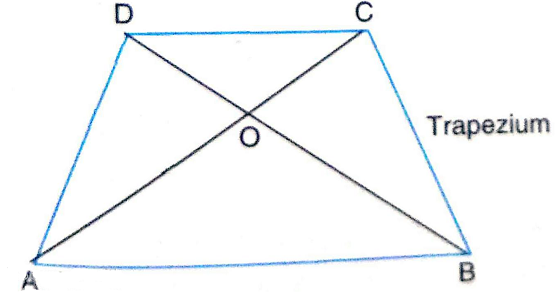
\angle AOB = \angle COD |Vert.opp.\angle S
\angle OAB = \angle OCD |Alt. Int. \angle S
[\because AB || DC (given)]
\therefore ∆ AOB ~ ∆ COD
|AA similarity criterion
\therefore \frac{ar(∆ AOB}{ar(∆ COD)} = (\frac{AB}{CD})^{2}
|\because The ratio of the areas of two similar triangles is equal to the square of the ratio of their corresponding sides
= (\frac{2CD}{CD})^{2} |\because AB = 2CD (given)
= (\frac{2}{1})^{2} = \frac{4}{1} = 4 : 1.
3.In Fig. 6.44, ABC and DBC are two triangles on the same base BC. If AD intersects BC at O, show that \frac{ar(ABC)}{ar(DBC)} = \frac{AO}{DO}.
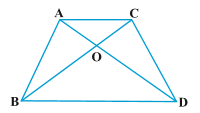
Sol.Given : In figure, ABC and DBC are two triangles on the same base BC and AD intersects BC at O.
To Prove : \frac{ar(∆ ABC)}{ar(∆ DBC)} = \frac{AO}{DO}
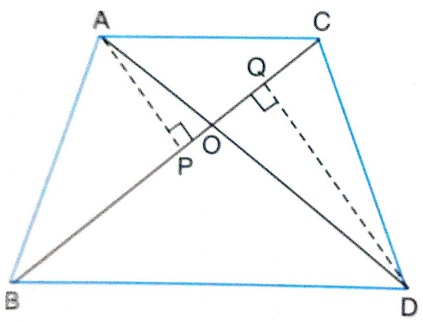
Construction : Draw AP \perp BC and DQ \perp BC.
Proof : In ∆ AOP and ∆ DOQ
\angle APO = \angle DQO
|Each equal to 90^{0} (By construction)
\angle AOP = \angle DOQ |vert.opp.\angle S
\therefore ∆ AOP ~ ∆ DOQ
|AA similarity criterion
\therefore \frac{AP}{DQ} = \frac{AO}{DO} … (1)
|\because Corresponding sides of two similar triangles are proportional
Now, \frac{ar(∆ ABC}{ar(∆ DBC} = \frac{\frac{1}{2}(BC)(AP)}{\frac{1}{2}(BC)(DQ)}
= \frac{AP}{DQ}
= \frac{AO}{DO} |From .... (1)
4.If the areas of two similar triangles are equal, prove that they are congruent.
Sol.Given : ∆ ABC and ∆ DEF are two similar triangle such that
ar(∆ ABC) = ar(∆ DEF)
To Prove : ∆ ABC \cong ∆ DEF
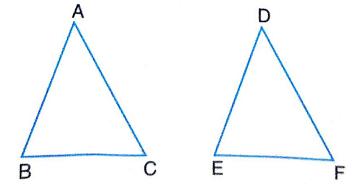
Proof : ∆ ABC ~ ∆ DEF |Given
\therefore \frac{ar(∆ ABC)}{ar(∆ DEF)} = (\frac{BC}{EF})^{2}
|\therefore The ratio of the areas of two similar triangles is equal to the square of the ratio of their corresponding sides
But ar (∆ ABC) = ar (∆ DEF) (given)
\Rightarrow 1 = (\frac{BC}{EF})^{2}
Taking square roots,
1 = \frac{BC}{EF}
\Rightarrow BC = EF … (1)
Also, \angle B = \angle E …. (2)
and \angle C = \angle F … (3)
|\because ∆ ABC ~ ∆ DEF (given)
In view of (1), (2) and (3),
∆ ABC \cong ∆ DEF
|ASA congruence criterion
5.D, E and F are respectively the mid-points of sides AB, BC and CA of ∆ ABC. Find the ratio of the areas of ∆ DEF and ∆ ABC.
Sol.Given :D, E and F are respectively the mid-points of sides AB, BC and CA of ∆ ABC.
To Determine. Ratio of the areas of ∆ DEF and ∆ ABC.
Determination.
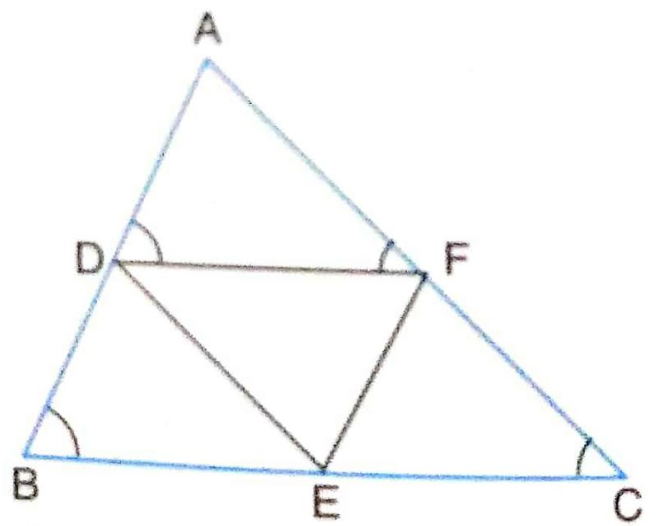
Because D and E are mid – points of sides AB and BC respectively of ∆ ABC (given),
\therefore DE || AC i.e., DE || AF
Similarly EF || AD
\therefore Quadrilateral ADEF is a parallelogram
\angle DEF = \angle A
[\because Opposite angles of a parallelogram are equal]
Arguing as above, BEFD is also a parallelogram.
\therefore \angle DFE = \angle B … (2)
[\because Opposite angles of a parallelogram are equal]
In view of (1) and (2),
∆ DEF ~ ∆ ABC
|AA similarity criterion
\therefore \frac{ar(∆ DEF)}{ar(∆ ABC)} = (\frac{DF}{BC})^{2}
|\because The ratio of the areas of two similar triangles is equal to the square of the ratio of their corresponding sides
= \left ( \frac{\frac{1}{2}BC}{BC} \right )^{2}
|\because D and F are the mid-points of AB and AC respectively \therefore DF || BC and DF = \frac{1}{2} BC
= (\frac{1}{2})^{2} = \frac{1}{4}
\therefore ar (∆ DEF): ar (∆ ABC) = 1 : 4.
Remark. \therefore ar (∆ ABC) : 4 ar (∆ DEF)
6.Prove that the ratio of the areas of two similar triangles is equal to the square of the ratio of their corresponding medians.
Sol.Given : Two triangles ABC and DEF such that
∆ ABC ~ ∆ DEF
Let AM and DN be their corresponding medians.
To Prove : \frac{ar(∆ ABC)}{ar(∆ DEF)} = (\frac{AM}{DN})^{2}
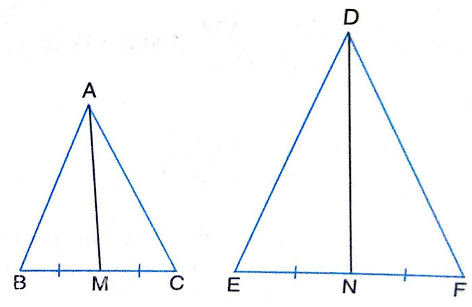
Proof : ∆ ABC ~ ∆ DEF |Given
\therefore \frac{ar(∆ ABC)}{ar(∆ DEF)} = (\frac{AB}{DE})^{2} ….. (1)
|\because The ratio of the areas of two similar triangles is equal to the square of the ratio of their corresponding sides and \frac{AB}{DE} = \frac{BC}{EF}
|\because The corresponding sides of two similar triangles are proportional
\Rightarrow \frac{AB}{DE} = \frac{2BM}{2EN}
|\because AM and DN are the medians \Rightarrow M is mid-point of BC and N is mid-point of EF.
= \frac{BM}{EN} …. (2)
Also, \angle ABM = \angle DEN …. (3)
|\because ∆ ABC ~ ∆ DEF
\therefore \angle ABC = \angle DEF
(Corresponding angles of two similar triangles are equal)
In view of (2) and (3),
∆ ABM ~ ∆ DEN
|SAS similarity criterion
\therefore \frac{AB}{DE} = \frac{BM}{EN} = \frac{AM}{DN} …. (4)
|\because Corresponding sides of two similar triangles are proportional
Putting \frac{AB}{DE} = \frac{AM}{DN} from (4) in (1), we have
\frac{ar(∆ ABC)}{ar(∆ DEF)} = (\frac{AM}{DN})^{2}.
7.Prove that the area of an equilateral triangle described on one side of a square is equal to half the area of the equilateral triangle described on one of its diagonals.
Sol.Given : ABCD is a square whose one diagonal is AC.
∆ BQC and ∆ APC are two equilateral triangles described on the side BC and diagonal AC of the square ABCD.
To Prove : ar (∆ BQC) = \frac{1}{2} ar(∆ APC)
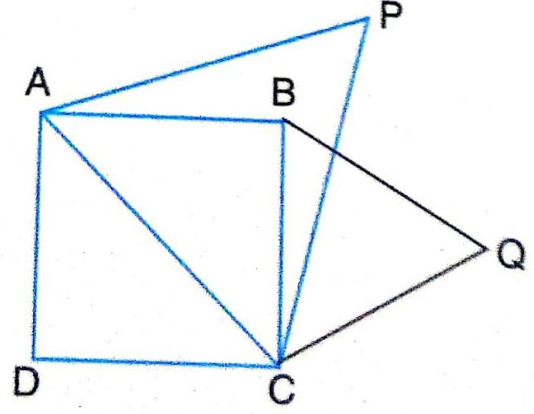
Proof : \because ∆ APC and ∆ BQC are both equilateral triangles
\therefore ∆ APC ~ ∆ BQC
|AAA similarity criterion
\therefore \frac{ar(∆ APC)}{ar(∆ BQC)} = (\frac{AC}{BC})^{2}
|\therefore The ratio of the areas of two similar triangles is equal to the square of the ratio of their corresponding sides
= (\frac{\sqrt{2}BC}{BC})^{2}
|\because Diagonal of square = \sqrt{2} side
= (\sqrt{2})^{2} = 2
\Rightarrow \frac{ar(∆ APC)}{ar(∆ BQC)} = 2
Cross – multiplying
2 ar (∆ BQC) = ar (∆ APC)
\Rightarrow ar (∆ BQC) = \frac{1}{2} ar(∆ APC).
TICK the correct answer and justify :
8.ABC and BDE are two equilateral triangles such that D is the mid-point of BC. Ratio of the areas of triangles ABC and BDE is
(A)2 : 1 (B)1 : 2 (C)4 : 1 (D)1 : 4.
Sol.\because ∆ ABC and ∆ BDE are both equilateral triangles
\therefore ∆ ABC ~ ∆ BDE
|AAA similarity criterion
\therefore \frac{ar(∆ ABC)}{ar(∆ BDE)} = (\frac{AB}{BD})^{2}
|\because The ratio of the areas of two similar triangles is equal to the square of the ratio of their corresponding sides

= (\frac{BC}{BD})^{2} |\because AB = BC = CA for equilateral ∆ ABC
= (\frac{2BD}{BD})^{2}
|\because D is the mid – point of BC
= \frac{4}{1}
\Rightarrow ar (∆ ABC) : ar (∆ BDE) = 4 : 1
Hence, (C) 4 : 1 is the correct answer.
9.Sides of two similar triangles are in the ratio 4 : 9. Areas of these triangles are in the ratio
(A)2 : 3 (B)4 : 9 (C)81 : 16 (D)16 : 81
Sol.Ratio of the areas of these triangles = 4^{2} : 9^{2}
|\because The ratio of the similar triangles is equal to the square of the ratio of their corresponding sides
Hence, (D) 16 : 81 is the correct answer.



0 Doubts's